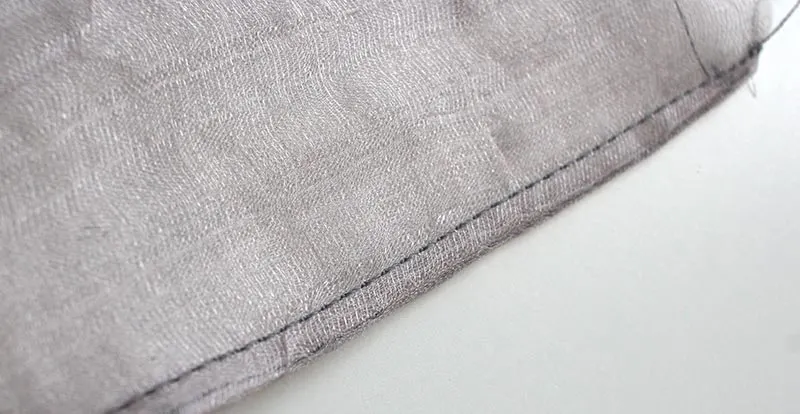In this sewing tutorial, you’re going to learn about French seams. We’ll cover French seam uses, some advantages and disadvantages of using a French seam, as well as an actual sewing tutorial on how to sew a French seam.
But, as I do get asked about sewing sheer fabrics, this sewing tutorial is going to be for sewing a French seam on sheer fabric!
Note though, the same method works on any other light- or medium-weight fabric, such as cotton, linen, etc.!
Did you know that English-speaking countries refer to this seam as a ‘French seam’ whilst those sewers in France refer to it as an English seam? Funny, right?
So let’s get some FAQs about French seams out the way first! (If you’d like to learn about sewing other types of seams, do pop back to this sewing seams post!)
And, if you prefer to watch, scroll to the end for the French seam sewing video tutorial!
What Is A French Seam Used For?
A French seam is an enclosed seam and is used to enclose the raw edges of fabric within the seam. French seams are constructed in two steps: the first being wrong sides together, and the second being right sides together.
You can use a French seam on sheer fabrics to hide the seam allowance and on non-sheer fabrics to keep the interior of the garment clean and tidy.

Disadvantages Of A French Seam
The main disadvantage of a French seam is the visibility of the seam. The seam isn’t fixed flat, so it has movement and can be pushed to either side of the actual seam line. This can be a pain when ironing, as you then often see the imprint of the seam on the right side of the garment.
Another disadvantage is that a French seam is almost impossible on thicker fabrics. These heavier weight fabrics just look cumbersome when French seams are used, as there is too much bulk contained within the enclosed seam.
What Is The Difference Between A French Seam And A Flat-Felled Seam?
Both the French seam and the flat-felled seams are enclosed seams, with the main difference between them being the way the seam lays after being sewn.
If you were to hold up two shirts, one made with French seams and the other with flat-felled seams, you will notice that the French seam can ‘flap about’ on the side seams, while the flat-felled seam sits flat.
Felled seams are great for medium- and heavy-weight fabrics, where a French seam would look too bulky and unprofessional.
What Is A Mock French Seam?
A mock French seam is created differently than a French seam, but still only utilises two seam lines:
- The fabric pieces are sewn right sides together, and the seam pressed open. (See this tutorial on how to sew an open seam!)
- The seam allowance is then pressed inwards with the raw edge meeting just before the stitched line.
- These fold lines are again pressed, the two pieces brought together and the folded edges edge-stitched together, enclosing all of the inside seam allowances.
How Do You Sew A French Seam On Sheer Fabric?

If you would like to know how to sew a French seam on sheer fabric, stay tuned. The step-by-step tutorial on sewing one further down was photographed using a sheer fabric for this reason!
You should know, however, that sheer fabrics are by nature more fragile and prone to damage.
What Size Needle Do You Need To Sew Sheer Fabric?
If you are following along sewing a French seam on sheer fabric, you may be wondering which size needle you should use for sewing sheers.
The answer is the thinnest possible and with a thread of the same colour. If your needle is too big it will leave visible holes in the sheer fabric, and if your thread colour is not a great match, it will be visible!
How Do You Sew A French Seam On A Curve?
Sewing a French seam on a curve is a little trickier than sewing a straight seam, so I’m making a completely separate tutorial for that one! Stay tuned for that!
How Do You Sew A French Seam?
Ok, ok! You wanna know how to sew a French seam, so let’s crack on with it! Start by grabbing supplies so that you can practise along with me. For this you will need:
- Sewing machine
- Thread
- Fabric pieces
- Scissors
- Tape Measure
I am sewing two pieces of sheer organza in this example so that those who would like to sew theirs on non-sheer fabric can sew along too. The steps are exactly the same for non-sheer fabrics, but be sure to choose a light- to medium-weight fabric!

Here’s an overview of the steps we will be taking, and then we’ll dig deep into each step with photos further below!
How To Sew A French Seam
- Place wrong sides of fabric together and pin in place.
- Sew one stitch line the length of the piece of fabric, or as long as needed.
- Press to set the stitches.
- Trim the seam allowance down by several millimeters as dictated by your sewing pattern.
- Turn the fabric pieces inwards now, so that right sides are facing each other.
- Press along the stitched edge.
- Sew the second line of stitches, enclosing the remainder of the seam allowance.
- Press to finish seam.
Now, there are other considerations when sewing this enclosed seam, such as:
- How wide you want the finished seam to be
- How tricky the fabric is to sew
- Whether the seam will be sewn straight or on a curve.
Lets’ get sewing!
Deciding Your Finished Seam Width
You need to decide how wide you want your finished seam to be. In this tutorial, I’m using a sheer organza fabric so I will go for a 4 mm finished seam so that it looks neat and hidden.

Next, note down how much seam allowance is included in the pattern you will be sewing. In my example, 1cm is provided, but in commercial sewing patterns it can be as much as 15mm.
Sewing patterns will usually have instructions included on the seam allowance amounts you should sew with for those seams needing French seams.
Now, pen and paper at the ready, take your preferred seam width amount from the seam allowance amount.
Mine is 10 mm – 4 mm = 6 mm.
This means I will sew my first seam line with a 6mm seam allowance. I’ll then trim 2-3 mm away and then the second line will be 4mm away from the first stitched line.
What if your seam allowance is 15 mm and you want a finished seam of just 5 mm?
15 mm – 5 mm = 10 mm
You would sew your first line with a 1 cm seam allowance, trim the allowance back to 4 mm, and then sew the second line 5 mm from the first line.
Perhaps you want a very wide French seam and the seams will actually be on the outside of your garment as a ‘design feature’?
In that case, perhaps you add a 5 cm seam allowance, and you want the finished seam width to be 3 cm.
5 cm – 3 cm = 2 cm
Your first sewn line will have a 2 cm seam allowance. If this was a design feature idea, you could also decide not to trim any seam allowance away as the 2 cm is less than the intended 3 cm seam width, and this would add a little more structure to the seam.
I know. That was a crazy ‘what if’, right…?
Moving on…
Sewing The Seam
Place the wrong sides of the fabric pieces together and sew a line down the edge, no wider than the amount you came to in the previous step.
Sew with a thread that matches your fabric – I am using a contrasting thread so that you can see what I’m doing in each of the photos! 🙂
I am sewing with a 6 mm seam allowance to the right, minus the wispy frayed bits!

Press the stitches to set them. Remember, you may need to use a pressing cloth to prevent the fabric from scorching.

Now, open up the fabric and press the seam open. This is tricky in the organza I am using, as you can see from the photos below!


Trim the seam allowance down so that what is left will fit within the final seam width amount. We do not want it trimmed so much that it immediately frays to nothing, but we do want it to be a lesser amount than our finished French seam width!


Now, place the right sides of the fabric together and press the seam so that it is a crisp finish – well, as crisp as you can get with the fabric you are using! Mine is a tad bouncy below!

Sew the second stitch line the amount you want your finished width to be. For me, this is 4 mm, which sees me lining up the edge of the fabric with the inside edge of my sewing machine foot.

As you sew, you should notice that the seam allowance from the first stitched seam is tucked inside the French seam, with no wispy hairs poking through.
When you’re finished with the second stitch line, press the stitches to set them.

Then, press the seam open to get a nice crisp finish. Voila – isn’t that just a lovely narrow French seam? (I know, the dark thread lets it down, but you wouldn’t have seen anything if I had sewn it with a matching thread!)


If you can see fabric or threads poking through, you either didn’t trim enough seam allowance away or you sewed with too little allowance the second time! On the lower part of the photo below, you can see a few wisps peeking through!

There you have it. A photographic step-by-step sewing tutorial on how to sew French seams. I hope it was helpful, and that it helps you to feel more confident about using this beautiful seam finishing technique!
French Seam Video Tutorial
Let me know in the comments below your thoughts on sewing seams, any struggles you had, and what else you’d like to see on the site!


Rosalie Galvez
Tuesday 24th of November 2020
This is perfect for pillowcase creases, children's clothing, sheer and satin. Thank god for French seams that delicate fabrics can last longer.
Carol
Thursday 16th of May 2019
Gosh I remember using french seams years ago before I got myself an over locker! You can’t beat them for sheer blouses. Thanks Eve
Eve Tokens
Thursday 16th of May 2019
Ah, I have to be honest with you - I rarely used my overlocker when it was with me! So much prefer a French seam. That said, I actually get it back in August when out things get shipped here, so maybe my feelings will change!